Congrats to Aussie javelin thrower Kim Mickle for her World Champs silver medal! Here’s our “Training Day” on Kim from February 2012.
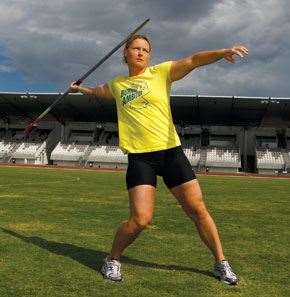 Photos by Theron Kirkman Photo
Photos by Theron Kirkman PhotoMickle, javelin national champion and Commonwealth Games medallist, entered her second Worlds in the hottest form of her life.
Kim Mickle’s personal story from the 2011 World Athletics Championships is that rare tale that manages to churn the stomach while warming the heart. It also reveals a secret: Sally Pearson wasn’t the only Aussie woman who deserved to return from Daegu in September a hero.
Mickle, 27, a six-time women’s javelin national champion and 2010 Commonwealth Games silver medallist, entered her second Worlds in the hottest form of her life. With her long-time coach Grant Ward in support, she gave herself a bolter’s chance of throwing well enough to land in the medals. The plan was to go out the first night and put down an easy distance to qualify for the final, then return the following night and let it rip on the biggest stage of her life. But Mickle’s DNA isn’t wired to hold something in reserve – while throwing at less than maximum thrust in qualifying, she felt a twinge near her spine.
“My back went into these horrible spasms,” she recalls. “The morning of the final, I couldn’t get out of bed. I couldn’t tie up my shoelaces. I had to have a cortisone shot and a local anaesthetic injection in my back, plus other painkillers and strapping, just so I could get to the warm-up area.”
What happened next remains one of the untold true-grit sporting stories of 2011. Rather than ruin the fun, we’ve let Mickle tell her own story. But we will reveal that the very likeable 27-year-old West Australian performed well enough under immense pressure and pain to earn Olympic pre-selection and book her ticket to the London Games in July.
Night of agony
“The night of the World Champs final, I literally could only do about one-tenth of my usual warm-up. I knew my back was stuffed and I couldn’t rotate my hips through, but rather than accept not being able to throw very far in the final, I thought I’d give it a real go by running in and slamming down on my left side; sort of like using the ol’ cricket bowling action.
“On my fourth throw I ran in and just felt this massive shot of pain down my side. [Mickle fell over the line in agony, recording a no-throw.] I’d find out after
the competition that I’d broken my 11th rib and torn seven centimetres of my oblique muscle off my ribs.
“Still, I thought since it was the final, I might as well keep throwing. The funny thing is my best throws were my fifth and sixth throws (61.96 metres and 61.33m). I finished sixth in the world. I’m surely the only thrower who can say I threw my Olympic qualifying distance with a broken rib and my obliques not attached to my ribs.
“A lot of people, including our medical staff, couldn’t believe what I did. But competing that night gave me the result I wanted, inasmuch as I gained pre-selection for the Aussie team for London and finished sixth in the world. So, I look back and know how painful it all was, but, oh, was it worth it!”
All-rounder
“You’ve got to love being an all-rounder if you’re going to train for javelin. I’m training six days a week. Each of those six days I’m on the track and in the gym, as well as doing specific throwing exercises. Then we add the cross-training elements – gymnastics, yoga, boxing, long-distance runs. My coaches and I are looking at adding a bit of rock climbing next.
“It sounds stupid, but I pretty much love all the training. Even the long-distance running kills me, but I know how good I’ll feel at the end of it. With my weights and track work, we change things up regularly so I don’t get sick of any of it. But my favourite exercise is still throwing. I just love to throw things ‒ no wonder I ended up in javelin ...
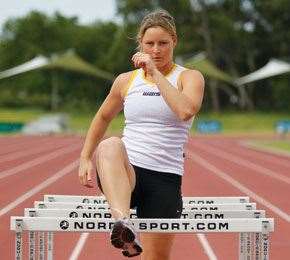 Photos by Theron Kirkman Photo
Photos by Theron Kirkman Photo“Javelin is a highly technical event; it’s not just power and throwing strength. What you have to do is create a bit of leverage, and you learn to contort your body to achieve this. We call it the ‘C’ position; from my ankle all the way to my extended arm, the overall shape should look like the letter ‘C’. That’s called the power position. From there it’s a slingshot action over the top of my block leg to throw. When we have a run-up, we get more length and more depth from what our legs are doing because we have speed on our side. The stresses on the body can be huge.”
On track
“My work on the track really varies. It might involve some sprints or hurdles, or a series of plyos [plyometric exercises]. It depends on the time of year and where I am in my training cycle. Right now I am doing longer track work to get some fitness in my legs. This means a lot of 400s.
“Coming up to a major comp, I’ll do short and sharp sprints. Usually this means between 60m and 30m. Right now I am doing 100s. And it’s not about holding form. For me, it’s all about going flat out and getting that explosive power happening. That means going as hard and as fast as I can, but being a thrower, when I get to about the 80m mark, I start to get a little wobbly.
“Doing hurdles really helps my flexibility and coordination and works the hip flexors and glutes. You need to be coordinated to throw a javelin, and you have to be coordinated over hurdles or you’re going to stack it – I know all about that ... ”
Pitch perfect
“We throw a baseball around as a really good warm-up all year-round, but right now, because of my rehab, I’m doing a lot more time with the ball and glove. It’s really important to put something light in my hand and keep my arm cocking over with the throwing action. It helps maintain and improve that speed in my arm. You obviously don’t throw a javelin the same way you throw a baseball, but it’s purely to maintain that muscle memory of throwing hard and fast.
“The baseball drill is really good when you’re coming up to a major event, especially if you’ve been lifting really heavy weights. After big weights, sometimes the javelin feels really, really light – it weighs 600g. So it’s great to put a baseball in my hands, because after working with the baseball, the javelin feels a bit heavier again and you can get some real purchase on it.
Playing the weighting game
“I do a lot of different weights exercises in the gym. The pull-over is probably the most important exercise I do. Javelin requires a lot of lat (latissimus muscle) movement and shoulder flexibility. Doing this exercise puts the body under a lot of stress, especially with the weights we use. I have to have my coaches and spotters around me.
“My best lift for pullovers is about 65kg – and all to throw a 600g javelin! Still, it’s a great exercise for my sport, because it strengthens those muscles up for when I get to throw. But it’s not easy – when I do it, everyone always stops what they are doing in the gym and watches me.
“The bench press is probably the most impressive exercise I do. My best bench press is 97.5kg, which most of the blokes in the gym can’t do. My aim is to get to 100kg before I leave for London. I also do a lot of squats to streng-then up my legs for the block when I throw, and my best is 130kg.
“I do all the Olympic lifts. These are dynamic lifts, like cleans and snatches. My best clean is 95kg and my biggest snatch is 70. Those are heavy lifts, enough to probably win me a bit of respect if I’m ever around real weightlifters ... ”
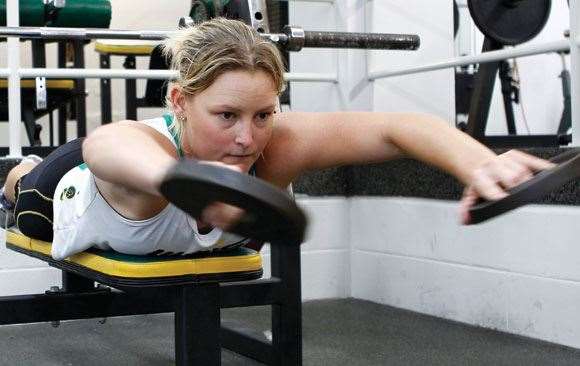 Photos by Theron Kirkman Photo
Photos by Theron Kirkman PhotoUp and up
“Chin-ups aren’t my best exercise. I tend to be in the gym when the pole vaulters are there and they’ll tie 30kg to themselves before doing chin-ups, while I struggle with my own bodyweight. I do 3 x 8 reps. I try to do them palms out, and fast and dynamic, so I’m not swinging and I’m using the right technique. It’s one thing I hate doing each day because I find it really hard.
“Push-ups are much more my thing. Recently we put the challenge out to everyone in the WAIS athletics group to see how many push-ups each person could do in a minute. I ended up winning it with 70. I was pretty stoked with that.”
Hitting the bars
“I do a gymnastics session every Wednesday. As part of that, I do exercises on the parallel bars for shoulder stability and core work. I normally do 3 x 10 swings, and then 3 x 10 swing and dips, which is a similar move, except I dip down, which requires a lot more tricep activation. It’s the same principle as the swings, but adds an extra strength element.
“I aim to do constant swings to engage all the tiny little muscles that people forget about when they concentrate on lifting big weights. On the bars, if you relax just one muscle group, you can fall. It’s a great reminder of how important all those little muscles in the shoulders and back are.
“I reckon doing exercises with your own body weight is just about the best thing you can do. We try to maximise the number of exercises I do using just my body weight. It’s safer [than lifting weights] and it’s also really hard work.”
Big Wednesdays
“After the Wednesday gymnastics session I usually work through a bit of a circuit straight after, so it can be pretty crazy. I’m in the gym [weights room] six days a week, and five of those days we are doing strength-based stuff – heavy, fast, explosive lifts at high intensity.
“So on a Wednesday I shake it up a bit. I do high reps, no rest, absolutely flat out, with a tough bit of cardio between sets either on the bike or the rowing or kayak machine. It’s not a nice session at all!”
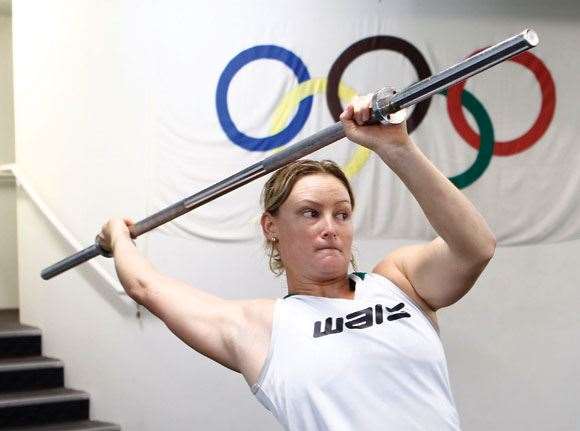 Photos by Theron Kirkman Photo
Photos by Theron Kirkman PhotoLong and the short
“A lot of people think because you’re a thrower, you must have to be massive and heavy, but javelin throwers, if you look at them, are fit as fiddles. Many of them could be heptathletes. But while I’m the same sort of size as the other girls, I’m a little shorter than you’d probably expect for my event. [Mickle is 168cm and weighs 69kg.] I’m average height for a regular person, it’s just that when I stand around the world’s best throwers, I look kind of short.
“In fact, I think I’m the smallest elite thrower. And, of course, the javelin is way taller than I am – if I’m on my tippy-toes I can just reach the top of it. When I first started throwing, someone told me I’d never be any good at javelin because I was too small. I feel pretty good about already proving that person wrong...
“I’ve relied on my arm my whole life. I’ve probably got one of the fastest arms in the world in terms of being able to throw a javelin. Sometimes we call my style the ‘arm bash’ – a typical Aussie way of how to do it, relying a bit on the old cricket backyard upbringing.
“One thing I’ve had to learn to do is hold my positions, and wait and wait and wait, and let my body do the work instead of just my arm. It’s hard to concentrate on doing that when you know you’ve got a really fast arm ready to rip. That’s one thing I’ve had to work on, and it’s going to really help me reach the longer distances.
“What I know is that what I lack in height, I gain in speed and agility. A lot of the girls lose their speed because they’re so tall. I get mine through my fast arm, and hopefully by the Olympics I’m using my body to work with my arm to really put together some great throws.”
Pre-selection
“Gaining that pre-selection for London 2012 from my Worlds performance is a huge benefit, especially since I’m coming back from an injury as well. If I didn’t have pre-selection, I probably would’ve had to rush my rehab and recovery, which is never a smart thing to do. You rush a rehab and you can carry an injury forever. So, since I was pre-selected, we could take the
right amount of time to fix up my rib and
oblique problems.
“Our planning is going perfectly. Obviously with the injuries I’ve had, I can’t do anything but cop it, work hard to get through them and look ahead. But I think we’re in a brilliant position now to not just make the final in London, but to mix it with the big medal hopes and give them a real run for their money. I can’t wait.”
‒ Travis Cranley
Related Articles
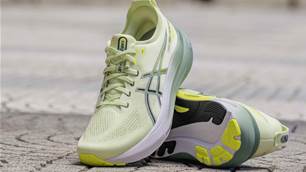
I was not born to run
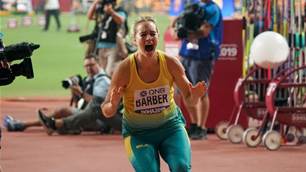
'Rio wasn't great': Aussie Javelin champion named Athlete of the Year













